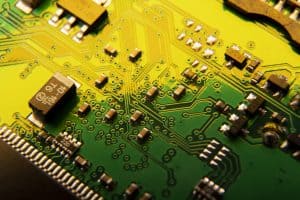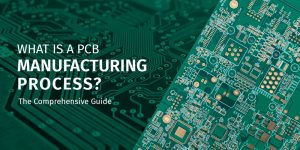As electronic consumers demand more efficient and effective products, SMT and SMD are increasingly becoming popular. Surface Mount Technology (SMT) is a revolutionary method of arranging components on a circuit board. This technique is known for its smallness, efficiency, and high operation speed. Surface Mount Devices (SMD) are the parts mounted onto bare boards in line with the design requirements.
Most people confuse SMT and SMD terms and often use both to refer to the same thing. Indeed, the technique and the parts are closely related and can cause some confusion. We have prepared this article to show the differences between SMT and SMD since they are essential in producing faster, reliable, and high-quality boards.
What is SMT?
As mentioned above, SMT is a modern method of arranging parts on a bare board. Previously, designers used leads to fix PCB components through apertures. They had to practice proper preparation to ensure that every lead formed and fitted appropriately to the PCB.
SMT assembly is a modern and effective method of soldering parts directly onto a PCB. By abolishing the requirement to pass leads through boards, the method has emerged faster, more efficient, and low-cost. It is also space-intensive, enabling more devices to be fitted on a small board. This further enables the production of miniaturized PCBs, prevalent in consumer electronics, like smartphones and wearables.
SMT is a complex process where every device is tactically arranged and fitted on a bare board for optimal performance. This is where the confusion between SMT and SMD arises from. To obtain a high-quality PCB, you need to select the right components and use the right mounting technique.
During the SMT process, you should apply estimated quantities of solder paste into the board before fixing them with a machine. As mentioned earlier, directly fitting devices on the surface are more effective than passing leads through the PCB. Besides, direct mounting makes the PCB perform optimally even in miniaturized parts.
SMT also enables PCB manufacturers to automate the mounting process. You can program equipment to arrange devices on a board in a short turnaround directly. This implies that the manufacturing process is quick, quality is guaranteed, and risks are greatly minimized.
The Advantages and Disadvantages of SMT
SMT components are small in size, easy to mount, and can be placed on both sides of the board, making SMT cheaper than through-hole mounting. However, the assembly process is complex since SMT devices experience various manufacturing issues.
If you require miniaturized, lightweight boards at cost-effective prices, SMT devices are ideal for you. They are smaller than through-hole components and are also lighter. Smaller devices facilitate tighter placement on a board, and since most consumer electronics emphasize size, this benefit is an important factor. Physically, SMT devices also allow faster placement during PCB assembly, facilitating cost-effective high production runs of products.
Despite the above benefits, SMT also has its drawbacks. For example, while you can mount parts more quickly, the mounting equipment is expensive. The high capital investment implies that SMT devices can increase costs, especially in low-volume runs. Surface-mounted devices demand more accuracy because of the complex process of routing blind and buried vias than in through-hole mounting. During the design stage, you must also be accurate since violations of your contract manufacturer’s (CM’s) DFM pad layout rules can create mounting problems, like tombstoning.
What is SMD?
Surface Mounted Devices (SMD) are the parts that are arranged and fixed into a bare board during PCB assembly. We live in the technology age, where consumers demand highly performing, and more flexible, miniaturized, and cost-effective electronic products. SMD serves these purposes well as they have pins that you can solder directly onto boards instead of relying on leads and wires.
The benefits of using pins instead of leads are many. For instance, you can apply miniaturized parts to get the same function. This implies that you can fix more devices into a smaller board and still maintain high functionality. The mounting process is also faster and cheap since you don’t have to bore holes through the PCB.
However, you must choose the right SMDs to produce a high-quality PCB. It is advisable to choose devices that fit well into your board and a compatible mounting technique. SMDs have evolved from manual soldering to automatic mounting on boards. With the appropriate mounting method, SMDs perform optimally throughout their lifespan.
Types of SMDs
Chip resistors: They have three digits on their surfaces, indicating the resistance value.
Network resistors: They are packages with multiple resistors sharing similar parameters, and they are only applicable in digital circuits.
Capacitors: Tantalum and aluminum capacitors are the most popular multilayer ceramic capacitors.
Diode: This is a common surface mount device that contains a colored ring on one side.
LEDs: There are standard LEDs and super brightness like the white, yellow, and blue LEDs.
Transistors: SMD transistors consist of inductors, transformers, fuses, and crystal oscillators.
IC: IC is an abbreviation for integrated circuits. They play essential roles in the proper functioning of electronics.
SMT Makes SMDs More Effective
Though the main difference between SMT and SMD is that one a mounting process, and the other refers to the mounted parts, there are some areas where they overlap. For instance, the right selection and fixing of SMDs is basically the main process behind SMT. Generally, SMT is a workflow for mounting SMDs.
Using the right mounting method can stir major improvements for prototypes. For instance, automated SMT equipment can mount numerous SMDs into PCB surfaces in a quick turnaround. Additionally, the devices you select for the production process will dictate the efficiency of the whole SMT process.
Generally, through-hole technology is still applicable in the PCB industry. Given the above applications, you should consider availability and cost factors. Unlike SMDs that are readily available, only a few through-hole devices are available.
What is Through-Hole Mounting?
This is the process of fixing components into drilled apertures on a PCB. Before the invention of SMT, through-hole was the SI unit of mounting components. Despite the reduction in popularity over the years, this technology is still applied because of its unique benefits, particularly reliability.
Through-hole devices are ideal for high-reliability electronics that demand stable connections between layers. While SMDs are linked to the board by solder, through-hole leads run through the PCB, enabling the devices to tolerate harsh environmental conditions. This is why the through-hole technique is commonly applied in military and aerospace electronics, which often experience high accelerations, temperatures, and collisions.
Besides, this method is also popular in prototyping applications, which often call for manual tunings and replacements. Generally, the through-hole technology has not completely disappeared from the PCB industry.
The Advantages and Disadvantages of Through-Hole Components
If you access the inside of most electronic products today, you will find few through-hole devices. However, this does not imply that they have become extinct; it is only that most PCBs today do not need their unique benefits. Through-hole components are ideal in physically demanding use cases with high heat and power requirements and in prototypes. But they are rarely applied in small PCBs, which need to be cost-effectively manufactured in high volume production runs.
Regarding severe temperature and shock requirements, through-holes’ benefits are found in the soldering process. Through-hole devices contain leads which you insert in the drilled openings before soldering them to copper pads. This makes the through-hole technology more secure than SMT and is why it is popular with applications experiencing more physical and thermal stress.
Through-hole devices are bigger than SMDs, meaning they can be applied in high-power applications. Besides, you can extract and replace through-hole devices easily during prototyping, especially when you want to test another components variant.
However, the through-hole technology also has disadvantages, particularly regarding board size, production costs, and processing time. You can mount SMDs more quickly than through-hole devices. The through-hole technique will also require you to drill holes through the board, increasing the production costs. Through-hole devices are also bigger than SMDs, and you can only solder them on one part of the board. Therefore, if you require a small board at a low-cost price, through-hole devices may not be ideal for your application.
Axial and Radial Lead Components
Through-hole devices are classified into axial and radial lead components. Axial leads run through a device in a straight line, with the lead wires exiting the device on any end. Manufacturers then mount the ends using two distinct board apertures, allowing dense packaging of components. On the other hand, radial lead parts stick out from the PCB since the leads are found on one end of the device.
Both these through-hole device types have their unique benefits. For example, lead devices are popular because of their snugness to the PCB, while radial leads are known to occupy less space, making them ideal for high-density circuits. Basically, axial lead designs include carbon resistors, electrolytic capacitors, fuses, and LEDs, while radial lead devices include ceramic disk capacitors.
Conclusion
While SMT is a modern mounting technique popular for facilitating compact mounting of components, through-hole is ideal for larger boards because it is more reliable. You should apply the through-hole technique when manufacturing military-grade circuits or circuits for harsh environmental conditions. If you are designing PCBs for consumer electronics, like smartphones and smart wearables, SMT will serve your needs better. Because of their unique benefits, neither of these methods will become extinct soon.
MKTPCB is a leading PCB manufacturing and assembling company based in Shenzhen, China. Kindly contact us to learn more about our PCB mounting services.











